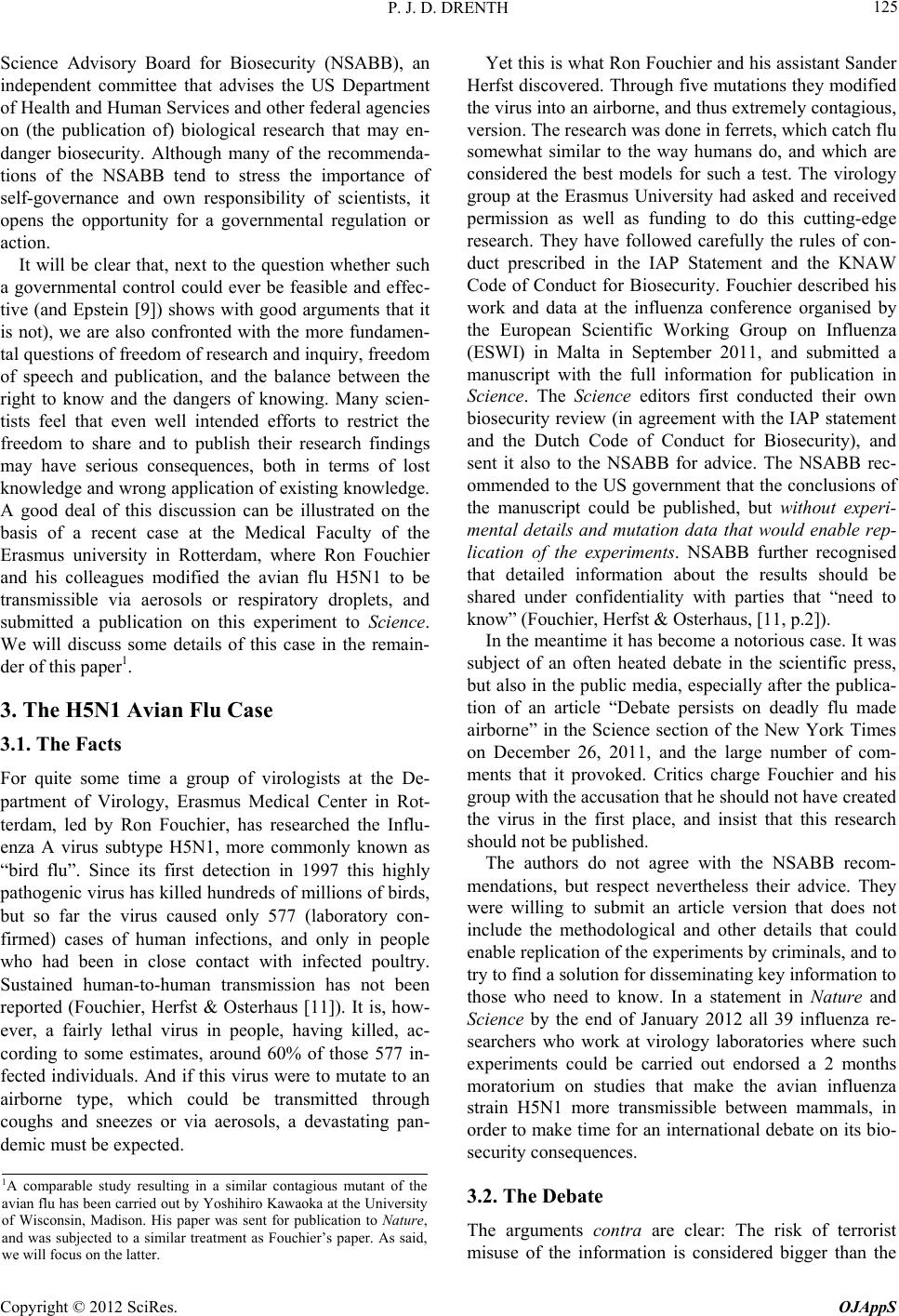
P. J. D. DRENTH 125
Science Advisory Board for Biosecurity (NSABB), an
independent committee that advises the US Department
of Health and Human Services and other federal agencies
on (the publication of) biological research that may en-
danger biosecurity. Although many of the recommenda-
tions of the NSABB tend to stress the importance of
self-governance and own responsibility of scientists, it
opens the opportunity for a governmental regulation or
action.
It will be clear that, next to the question whether such
a governmental control could ever be feasible and effec-
tive (and Epstein [9]) shows with good arguments that it
is not), we are also confronted with the more fundamen-
tal questions of freedom of research and inquiry, freedom
of speech and publication, and the balance between the
right to know and the dangers of knowing. Many scien-
tists feel that even well intended efforts to restrict the
freedom to share and to publish their research findings
may have serious consequences, both in terms of lost
knowledge and wrong app lication of existing kno wledge.
A good deal of this discussion can be illustrated on the
basis of a recent case at the Medical Faculty of the
Erasmus university in Rotterdam, where Ron Fouchier
and his colleagues modified the avian flu H5N1 to be
transmissible via aerosols or respiratory droplets, and
submitted a publication on this experiment to Science.
We will discuss some details of this case in the remain-
der of this paper1.
3. The H5N1 Avian Flu Case
3.1. The Facts
For quite some time a group of virologists at the De-
partment of Virology, Erasmus Medical Center in Rot-
terdam, led by Ron Fouchier, has researched the Influ-
enza A virus subtype H5N1, more commonly known as
“bird flu”. Since its first detection in 1997 this highly
pathogenic virus h as killed hundreds of millions of b irds,
but so far the virus caused only 577 (laboratory con-
firmed) cases of human infections, and only in people
who had been in close contact with infected poultry.
Sustained human-to-human transmission has not been
reported (Fouchier, Herfst & Osterhaus [11]). It is, how-
ever, a fairly lethal virus in people, having killed, ac-
cording to some estimates, around 60% of those 577 in-
fected individuals. And if this virus were to mutate to an
airborne type, which could be transmitted through
coughs and sneezes or via aerosols, a devastating pan-
demic must be expected.
Yet this is what Ron Fouchier and his assistant Sander
Herfst discovered. Through five mutations they modified
the virus into an airborne, and thus extremely contagious,
version. The research was done in ferrets, which catch flu
somewhat similar to the way humans do, and which are
considered the best models for such a test. The virology
group at the Erasmus University had asked and received
permission as well as funding to do this cutting-edge
research. They have followed carefully the rules of con-
duct prescribed in the IAP Statement and the KNAW
Code of Conduct for Biosecurity. Fouchier described his
work and data at the influenza conference organised by
the European Scientific Working Group on Influenza
(ESWI) in Malta in September 2011, and submitted a
manuscript with the full information for publication in
Science. The Science editors first conducted their own
biosecurity review (in agreement with the IAP statement
and the Dutch Code of Conduct for Biosecurity), and
sent it also to the NSABB for advice. The NSABB rec-
ommended to the US government that the conclusions of
the manuscript could be published, but without experi-
mental details and mutation data that would enable rep-
lication of the experiments. NSABB further recognised
that detailed information about the results should be
shared under confidentiality with parties that “need to
know” (Fouch ier, Herfst & Osterhaus, [11, p.2]).
In the meantime it has become a notorious case. It was
subject of an often heated debate in the scientific press,
but also in the public media, especially after the publica-
tion of an article “Debate persists on deadly flu made
airborne” in the Science section of the New York Times
on December 26, 2011, and the large number of com-
ments that it provoked. Critics charge Fouchier and his
group with the accusation that he should not have created
the virus in the first place, and insist that this research
should not be publish ed .
The authors do not agree with the NSABB recom-
mendations, but respect nevertheless their advice. They
were willing to submit an article version that does not
include the methodological and other details that could
enable replication of th e experiments by criminals, and to
try to find a solution for disseminating key information to
those who need to know. In a statement in Nature and
Science by the end of January 2012 all 39 influenza re-
searchers who work at virology laboratories where such
experiments could be carried out endorsed a 2 months
moratorium on studies that make the avian influenza
strain H5N1 more transmissible between mammals, in
order to make time for an international debate on its bio-
security consequences.
1A comparable study resulting in a similar contagious mutant of the
avian flu has been carried out by Yoshihiro Kawaoka at the University
of Wisconsin, Madison. His paper was sent for publication to Nature,
and was subjected to a similar treatment as Fouchier’s paper. As said,
we will focus on the latter.
3.2. The Debate
The arguments contra are clear: The risk of terrorist
misuse of the information is considered bigger than the
Copyright © 2012 SciRes. OJAppS